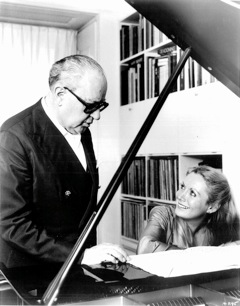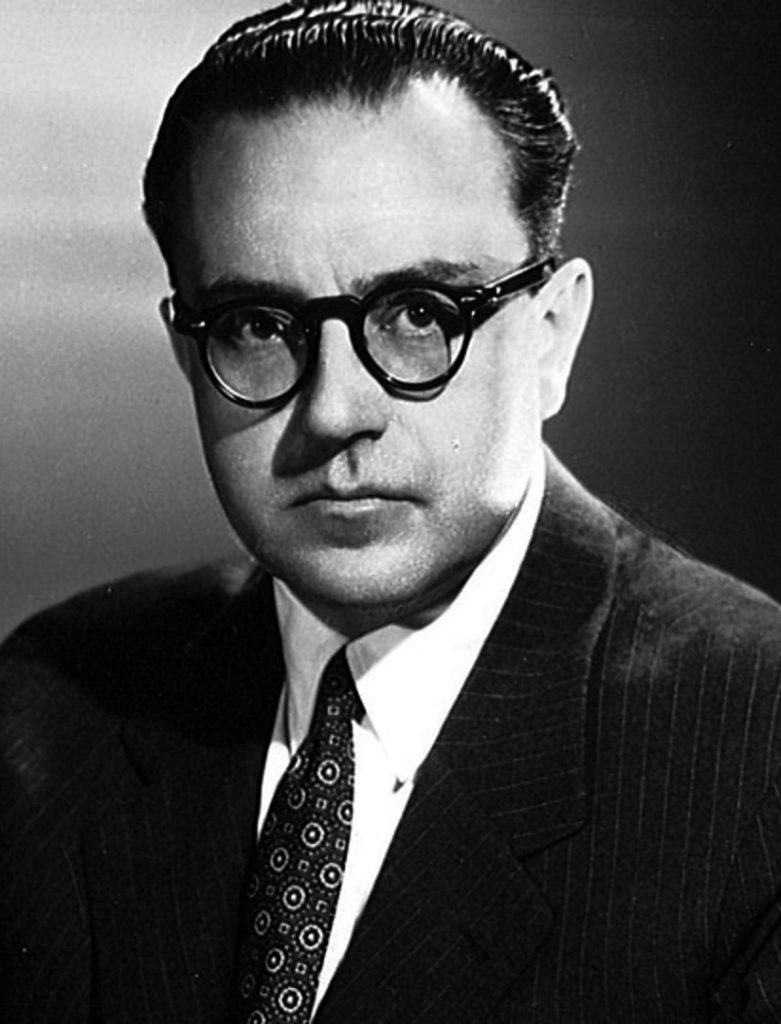
THIS WEEK IN PIANO HISTORY, we celebrate the birth of Argentine composer Alberto Ginastera, born on April 11, 1916. Ginastera has been described as an important composer in the history of Argentina, with an impact on the collection and dissemination of folk music similar to that of Bartók in Hungary.1
Ginastera was born in Buenos Aires, Argentina. He began his official musical studies at the age of seven and studied at both the Conservatorio Williams, where he received a gold medal in composition, and the Conservatorio Nacional de Música.2 His early musical influences included Athos Palma, José Gil, José André, and later in life, Aaron Copland, with whom he studied at Tanglewood. Ginastera began to rise to national prominence as a composer in Argentina after his suite Panambí was conducted by Juan José Castro.3 From here, a range of commissions and teaching opportunities gradually solidified his name as one of the most important composers from Latin America.



Ginastera’s teaching career was extensive and included a variety of universities in Argentina including the Conservatorio Nacional, Liceo Militar General San Martín, the Conservatorio de Música y Arte Escénico in La Plata, and the Facultad de Artes y Ciencias Musicales at the Universidad Católica Argentina where he served as a dean for five years. Additionally, he was named the founding director of the Centro Latinoamericano de Altos Estudios Musicales (CLAEM) at the Instituto Torcuato di Tella in Buenos Aires. At various times, political challenges brought on by the Perón administration required him to leave or resign posts in Argentina.4 During the first of these challenges from the Argentine government in 1945, Ginastera fled to the United States where he stayed for over two years on a Guggenheim grant.5 After his return to Argentina, Ginastera again suffered due to the political influence of the Perón administration who made him resign temporarily from the faculty of the Conservatorio de Música y Arte Escénico in La Plata.6
Although well known for his ballets, operas, and symphonic works, Ginastera is perhaps equally well known for his impressive oeuvre of piano works which contains three sonatas, three concerti, the Danzas Argentinas, Op. 2, the Suite de Danzas Criollas, Op.15, and other works for solo piano. A popular work for advanced pianists, the Danzas Argentinas, Op. 2 contains three short dances that recall references to the guitar, the pampas (Argentine plain regions), and the varied dance genres of his home country. His Suite de Danzas Criollas, Op.15 contains five different dances that monopolize the full range and coloristic possibilities of the piano. Listen to this recording, by our very own, pianist Alejandro Cremaschi. Ginastera’s Piano Sonata No. 1, Op. 22, from 1952, is another of his most popular piano works. The piece includes evocations to Argentine dances and the guitar within a four movement structure.
One of the most prominent proponents of Ginastera’s music is concert pianist Barbara Nissman, who met Ginastera while he was Composer-In-Residence at the University of Michigan.7 During his time in Michigan, Nissman performed his first piano concerto and Ginastera invited her to perform it again during his sixtieth birthday in Geneva, Switzerland. Nissman has since gone on to record and perform all of Ginastera’s piano music, including the two numbered piano concertos as well as the Concierto Argentino, which she was given exclusive rights to perform.8 Interested in learning more about Nissman’s relationship with Ginastera? Watch this video highlighting her personal connection to Ginastera.
Ginastera’s life took a dramatic turn late in his life causing him to separate from his wife, and later he married the cellist Aurora Nátola.9 He moved to Geneva where he spent the remainder of his days and died at the age of 67. Ginastera’s life achievements were recognized by honorary doctorates from Yale University and Temple University as well as the UNESCO International Music Council Music Prize, which he received in 1981.10
Interested in learning more about Ginastera? Learn about him and his pedagogical works in our new course: Exploring Latin American Piano Music: A Cultural Journey with Elementary through Early-Advanced Pieces.

OTHER RESOURCES YOU MIGHT ENJOY:
- MAGAZINE ARTICLE: Gabriela Montero: From Advocacy to Artistry by Luis Sanchez
- MAGAZINE ARTICLE: The Composer’s Score from Conception to Publication: The Evolution of Ginastera’s Piano Sonata No. 2 by Victor Labenske
- WEBINAR ARCHIVE: Ginastera: 12 American Preludes, Op.12 with Alejandro Cremaschi
- MAGAZINE ARTICLE: Dance and the Music of Argentine Composers by Hyrum Arnesen
- DISCOVERY POST: This Week in Piano History: The Birth of “Mr. Harmony” by Curtis Pavey
- REPERTOIRE VIDEO SERIES: Ponce: 20 Piezas fáciles sobre temas mexicanos by Desireé Miller-González
- DISCOVERY POST: Five Things You Might Not Know About Lita Spena by Florencia Zuloaga
- REPERTOIRE VIDEO SERIES: Ginastera: 12 American Preludes, Op.12 by Alejandro Cremaschi
- Use our search feature to discover more!
Sources
- Marilou Carlin, “Celebrating Music of Alberto Ginastera,” News & Features (blog), University of Michigan, November 21, 2011, arts.umich.edu/news-features/music-of-alberto-ginastera/.
- Deborah Schwartz-Kates, “Ginastera, Albertom” Grove Music Online, 2001, Accessed 20 Mar. 2023, oxfordmusiconline-com.uc.idm.oclc.org/grovemusic/view/10.1093/gmo/9781561592630.001.0001/omo-9781561592630-e-0000011159.
- Ibid.
- Ibid.
- Ibid.
- Ibid.
- Marilou Carlin, “Celebrating Music of Alberto Ginastera,” News & Features (blog), University of Michigan, November 21, 2011, arts.umich.edu/news-features/music-of-alberto-ginastera/.
- Ibid.
- Deborah Schwartz-Kates, “Ginastera, Albertom” Grove Music Online, 2001, Accessed 20 Mar. 2023, oxfordmusiconline-com.uc.idm.oclc.org/grovemusic/view/10.1093/gmo/9781561592630.001.0001/omo-9781561592630-e-0000011159.
- Ibid.
Carlin, Marilou. “Celebrating Music of Alberto Ginastera.” News & Features (blog). University of Michigan, November 21, 2011. arts.umich.edu/news-features/music-of-alberto-ginastera/.
Schwartz-Kates, Deborah. “Ginastera, Alberto.” Grove Music Online. 2001; Accessed 20 Mar. 2023. oxfordmusiconline-com.uc.idm.oclc.org/grovemusic/view/10.1093/gmo/9781561592630.001.0001/omo-9781561592630-e-0000011159.